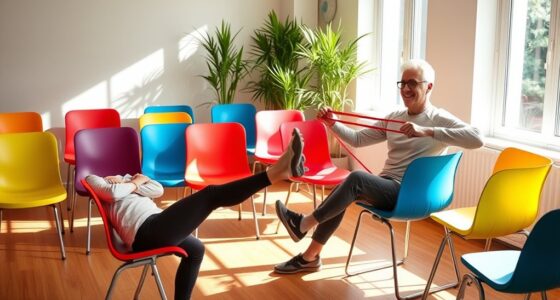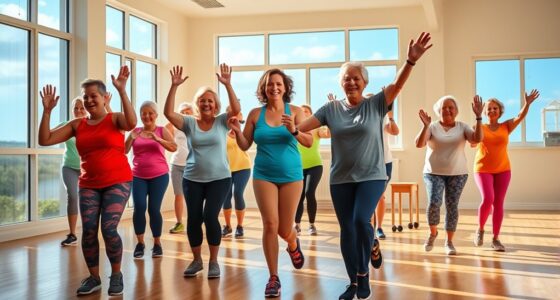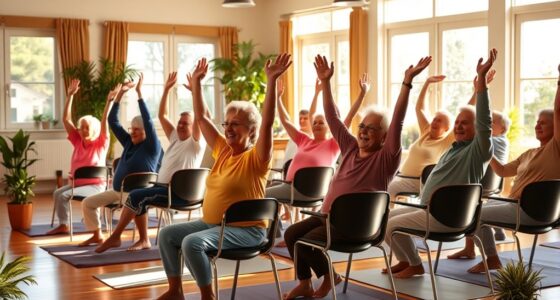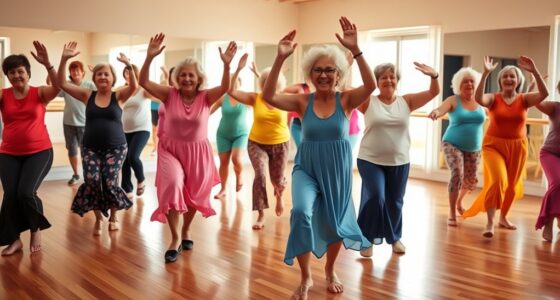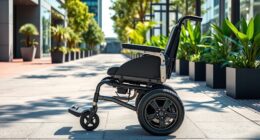To stay energized, seniors should focus on low-impact aerobic exercises like brisk walking, swimming, or cycling. These activities boost cardiovascular fitness, enhance mood, and prevent falls while minimizing joint strain. Aim for 150 minutes a week of moderate-intensity workouts, and be sure to monitor your heart rate to stay within safe limits. Enjoyable activities like dance classes or group workouts can also keep you motivated. There’s plenty more to explore about aerobic routines that can fit your lifestyle.
Key Takeaways
- Brisk walking is a great low-impact aerobic exercise that enhances cardiovascular health without stressing joints, keeping seniors energized.
- Swimming and water aerobics provide excellent strength and endurance benefits while being gentle on the body, making them ideal for seniors.
- Cycling, whether stationary or outdoor, improves cardiovascular fitness and can be adjusted for various intensity levels, ensuring a fun workout.
- Group fitness classes like SilverSneakers foster social interaction and motivation, helping seniors stay engaged and energized during workouts.
- Dancing not only boosts cardiovascular fitness but also enhances mood and coordination, making it an enjoyable way for seniors to stay active.
Understanding the Importance of Aerobic Exercise for Seniors
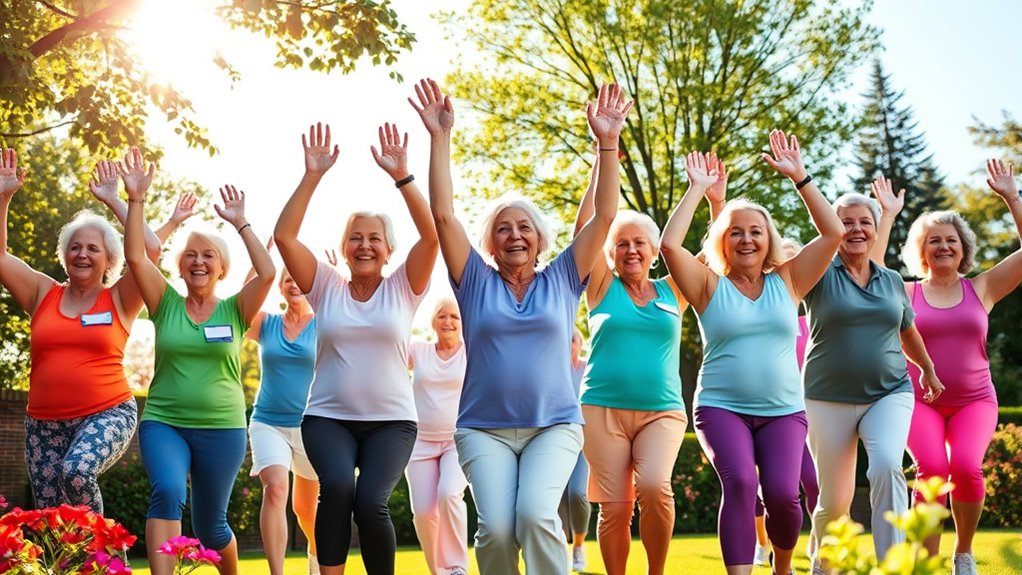
As you age, staying active becomes increasingly important, and aerobic exercise plays a key role in maintaining your health. Engaging in regular aerobic activities helps keep your heart rate and breathing in check, which is essential for cardiovascular health. This reduces your risk of heart disease, hypertension, and stroke, allowing you to enjoy life more fully. You’ll also experience enhanced bone density and muscle strength, significant for preventing falls and maintaining mobility. Furthermore, consistent aerobic workouts boost cognitive function and mental health, helping alleviate symptoms of depression and anxiety. Additionally, increased smartphone usage among seniors can encourage social connections and promote engagement in various physical activities. Regular aerobic exercise is particularly beneficial during critical periods of development, as it can help maintain physical and mental agility in older adults. Moreover, participating in aerobic exercises can improve overall health outcomes by reducing the risk of chronic conditions such as diabetes and certain cancers. By incorporating stress management techniques into your routine, you can further enhance the benefits of aerobic exercise on your overall well-being. In addition to these advantages, engaging in regular exercise can be complemented by understanding state-specific retirement benefits, which can help seniors optimize their financial and health planning as they age.
Key Benefits of Regular Aerobic Workouts

Regular aerobic workouts offer a multitude of benefits that can greatly enhance your quality of life as you age.
These exercises strengthen your heart, improving cardiovascular health and reducing the risk of heart disease. You’ll also notice improvements in cognitive function, helping to prevent memory decline and lower the risk of dementia. Engaging in regular aerobic activity can contribute to better medication management for dementia, ensuring that you maintain optimal mental health as you age. Additionally, the emphasis on iterative processes in your exercise routine can help you continuously improve your fitness levels. Incorporating antioxidant-rich foods into your diet can further support your overall health during exercise. It’s also important to consider that engaging in regular aerobic activity can help reduce the risk of complications such as infections related to decreased immune function.
Regular aerobic activity supports healthy bone density, essential for preventing fractures and falls. Additionally, you can experience reduced anxiety and depression symptoms, promoting better mental health.
As you stay active, you’ll likely enjoy increased longevity, with research showing that even moderate exercise can extend your life expectancy. Engaging in regular physical activity can also enhance your personal and community resilience, preparing you for both physical and mental challenges as you age.
Always consult your healthcare provider before starting any new exercise routine to guarantee it’s right for you.
Recommended Aerobic Exercises for Seniors
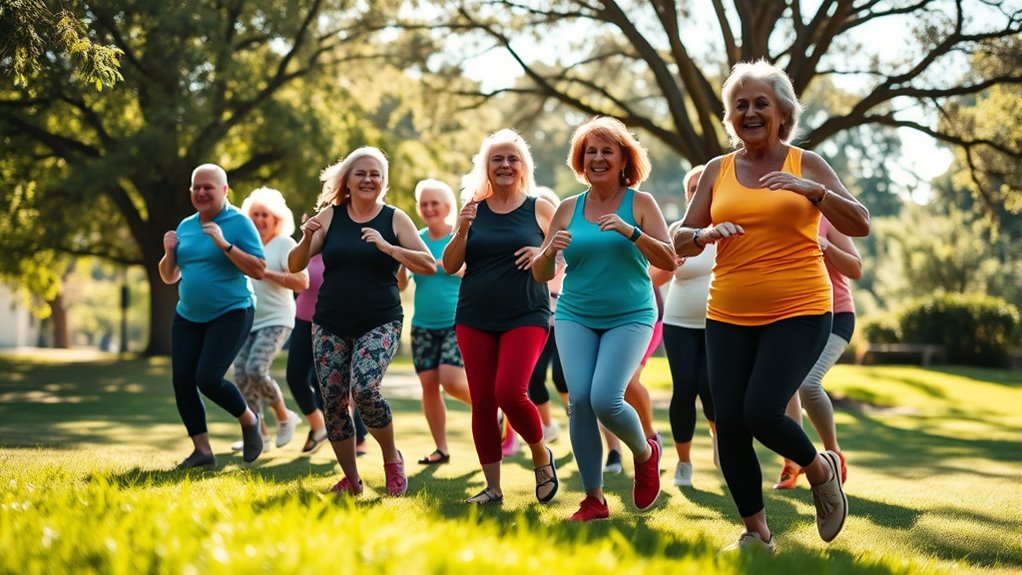
Seniors have a variety of enjoyable aerobic exercises to choose from, each catering to different fitness levels and preferences.
Brisk walking is one of the most recommended aerobic exercises for seniors, offering cardiovascular benefits without stressing the joints.
Swimming and water aerobics are also great low-impact options, enhancing strength and endurance while being gentle on the body.
Cycling, whether on a stationary bike or outdoors, helps improve cardiovascular health and can be adjusted for intensity.
Participating in group fitness classes like SilverSneakers fosters social connections and motivation.
Finally, dancing is a fun way to stay active, improving coordination and cardiovascular fitness while allowing for personal expression. Regular exercise participation can lead to improved overall health and well-being.
Each option helps you maintain a healthy lifestyle and enjoy your golden years.
How Much Aerobic Exercise Should Seniors Aim For?
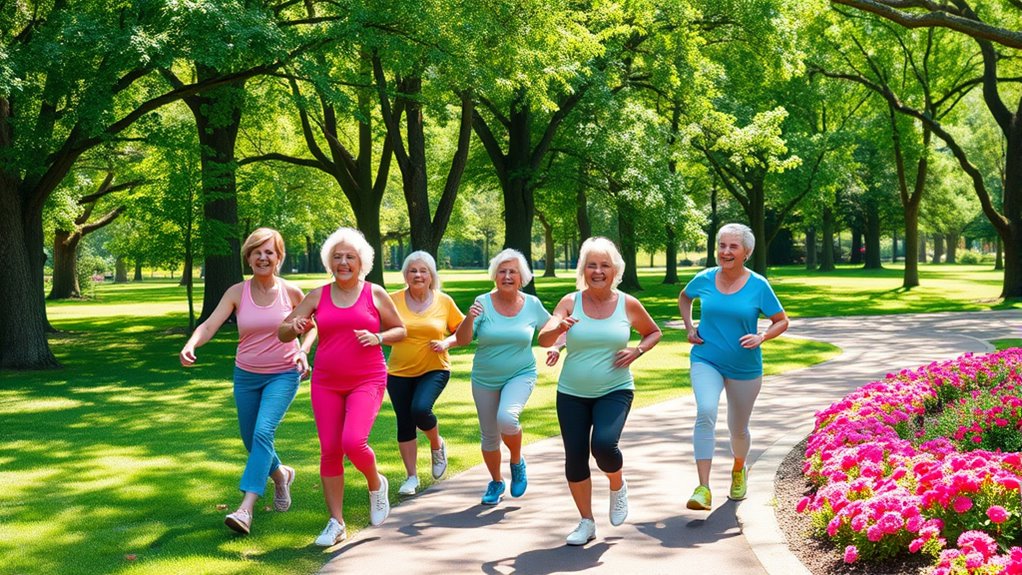
Aim for 150 to 300 minutes of moderate-intensity aerobic exercise each week to stay healthy and active. If you prefer, you can also choose 75 to 150 minutes of vigorous-intensity exercise. Mixing both moderate and vigorous activities can help you tailor your exercise program to fit your fitness level and personal preferences. It’s best to spread your workouts throughout the week, ideally participating three to four times, to avoid overloading any single day. Incorporating high vibrational energy during your workouts can enhance your overall experience and results. Engaging in regular aerobic exercise can also support mental health by reducing stress and improving mood. In addition, staying physically active can help lower the risk of chronic health conditions, contributing to a healthier lifestyle. If you’re new to exercising, gradually increase the duration and intensity to prevent injury. Always consult with your healthcare provider before starting a new aerobic exercise regimen, especially if you have chronic health conditions. This guarantees a safe and effective approach to your fitness journey. Additionally, consider risk management strategies to ensure a balanced approach to your overall well-being. Moreover, planning for your future fitness needs can help you make informed decisions about estate planning as you age.
Monitoring Intensity During Aerobic Workouts
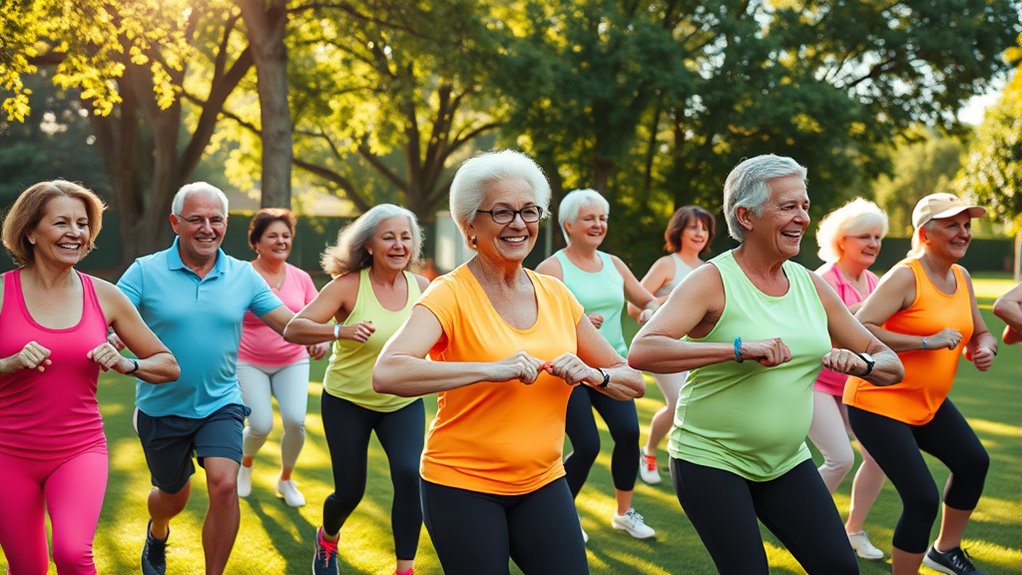
Understanding the right intensity level during aerobic workouts is key to maximizing benefits and minimizing risks. You can monitor intensity effectively using the “talk test”; if you can’t hold a conversation, you’re likely pushing too hard.
The CDC’s 10-point scale helps too—aim for a moderate intensity level between 5-6. For a 65-year-old, that means keeping your heart rate between 78-132 beats per minute. Juice cleansing can serve as a detoxification method that may support overall wellness, especially when paired with regular exercise. Higher contrast ratios can also enhance your visual experience during home workouts by ensuring you can clearly see instructional videos. Additionally, maintaining a consistent budget for fitness-related expenses can help you stay committed to your workout routine. Regular use of air purifiers can also improve indoor air quality, which is beneficial for maintaining energy levels during exercise.
Consider using heart rate monitors or activity trackers to stay on track. It’s essential to start slowly and gradually increase your workout intensity. Continuous learning about your body’s responses can enhance your overall fitness journey.
Don’t forget to include warm-up and cool-down periods to protect yourself from injury while ensuring your aerobic sessions remain safe and effective.
Safety Tips for Seniors Engaging in Aerobic Exercise
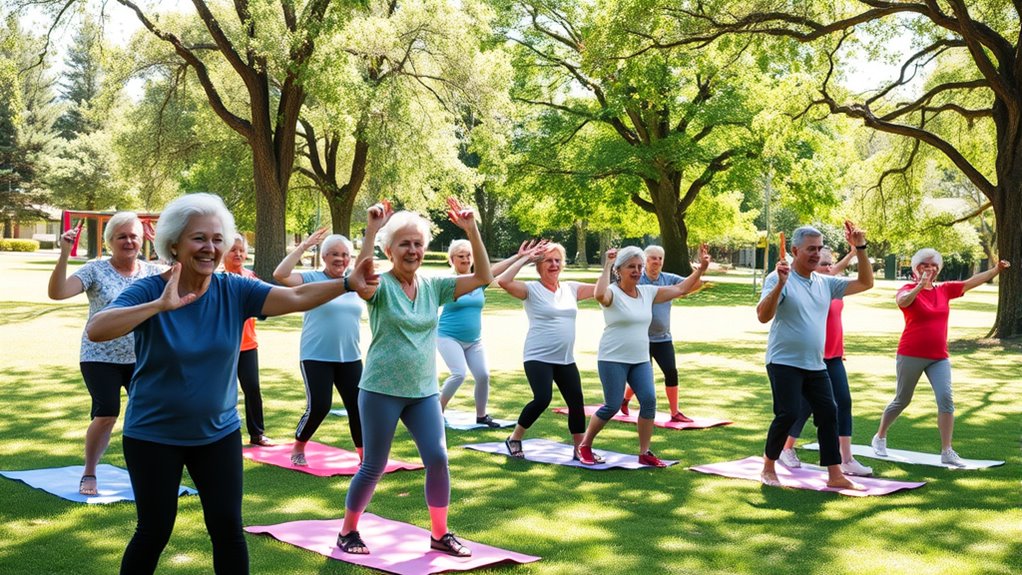
Engaging in aerobic exercise can be a fantastic way for older adults to boost their health and well-being, but safety should always come first.
Here are some essential safety tips to keep in mind:
- Consult Your Healthcare Provider: Always check with your doctor before starting a new exercise program, especially if you have chronic health conditions. Regular check-ups can help ensure that you are in optimal health to begin exercising. Additionally, it’s important to consider your overall financial considerations in planning for any necessary medical support during your fitness journey. Understanding your body’s required minimum distributions can also help you manage your health better as you age.
- Start Slow: Gradually increase the duration and intensity of your workouts to prevent injury.
- Warm-Up and Cool Down: Incorporate these routines to reduce injury risk and aid recovery.
- Monitor Your Heart Rate: Aim to stay within 50-70% of your maximum heart rate during moderate-intensity exercises for ideal safety.
Additionally, consider incorporating portable power banks into your outdoor aerobic activities to ensure your devices remain charged for tracking your fitness progress.
Modifications for Those With Joint Pain or Mobility Limitations
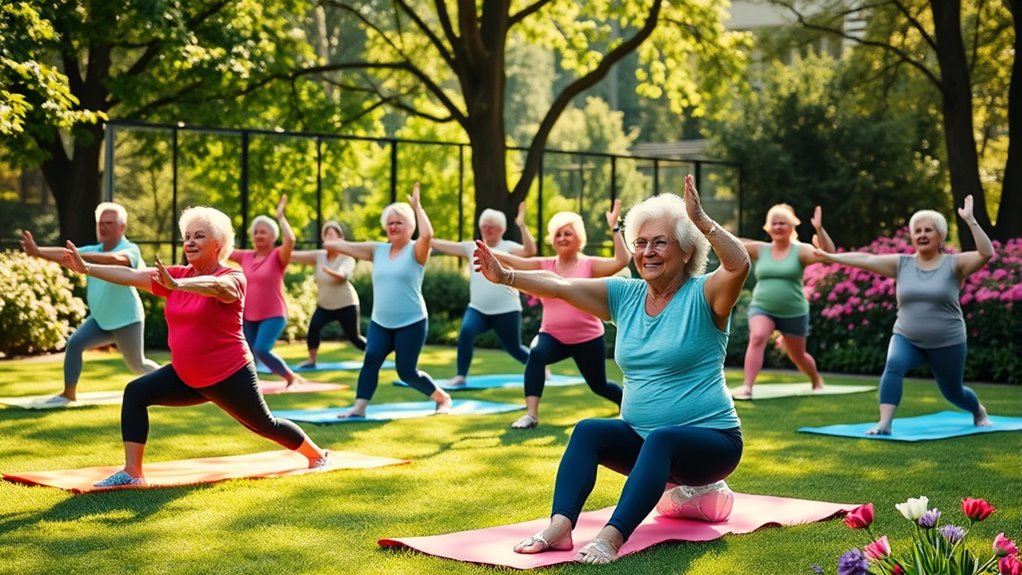
If you have joint pain or mobility limitations, there are plenty of gentle exercise alternatives that can keep you active.
Low-impact activities like swimming or cycling allow you to build endurance while protecting your joints.
It’s also important to gradually increase the intensity of your workouts to guarantee you stay comfortable and safe.
Gentle Exercise Alternatives
For seniors dealing with joint pain or mobility limitations, finding suitable exercise options can feel challenging, but there are plenty of gentle alternatives that provide cardiovascular benefits without stressing the joints.
Here are some effective low-impact options to contemplate:
- Swimming or Water Aerobics: Enjoy the buoyancy of water, which supports your body and reduces joint strain.
- Cycling: Use a stationary bike or ride outdoors for a cardiovascular workout that’s easy on your knees.
- Chair Yoga: This gentle practice enhances flexibility and strength while being accessible for those with mobility issues.
- Side-Step Jacks or Squats with Knee Raises: These exercises promote stability and endurance without harsh impacts.
Incorporating these gentle exercise alternatives can help you stay active and energized!
Low-Impact Activity Suggestions
While staying active is essential for maintaining health and vitality, seniors with joint pain or mobility limitations can benefit from low-impact activities that provide an effective workout without discomfort.
Swimming, water aerobics, and cycling are excellent choices, as they minimize stress on your joints while delivering cardiovascular benefits. You might also try brisk walking or using an elliptical machine, which allows you to engage in aerobic activity without the harsh impact of running.
For a fun twist, incorporate exercises like Side-Step Jacks, Squat With Knee Raises, and Knee Drives to enhance coordination.
Always start with gentle stretching and warm-ups to improve flexibility and reduce injury risks, making your low-impact activity even more enjoyable and effective.
Gradual Intensity Progression
Starting with low-impact aerobic exercises sets a strong foundation for seniors facing joint pain or mobility limitations.
Gradual intensity progression is crucial to help you safely increase your endurance while minimizing the risk of injury. Here’s how to approach your routine:
- Begin with short sessions of 10-15 minutes.
- Gradually increase the duration and intensity as your body adapts.
- Incorporate activities like brisk walking or cycling to strengthen muscles around your joints.
- Utilize modifications such as seated exercises or assistive devices for added safety.
Always consult your healthcare provider before starting a new exercise program.
This guarantees that your chosen activities align with your health status and capabilities, allowing you to stay energized and active.
Getting Started With a Regular Aerobic Routine

Getting into a regular aerobic routine can be a rewarding journey for seniors, and it only takes 150 minutes of moderate exercise each week to reap significant benefits. When beginning any new exercise, start with low-impact activities like brisk walking, swimming, or cycling. Gradually increase your workout duration and intensity to help your body adapt. Enjoyable activities, such as group classes or dance, can keep you motivated and engaged.
| Activity Type | Duration (Minutes) |
|---|---|
| Brisk Walking | 30 |
| Swimming | 30 |
| Cycling | 30 |
| Dance Class | 30 |
| Group Exercise | 30 |
Frequently Asked Questions
What Is the Best Aerobic Exercise for Seniors?
When considering the best aerobic exercise for seniors, think about activities that you enjoy and can sustain.
Brisk walking, swimming, or cycling are great options that keep your heart healthy without putting too much stress on your joints.
You might also want to explore low-impact classes like water aerobics or tai chi, which can improve your balance and coordination.
Aim for at least 150 minutes of moderate exercise each week to maintain your energy and health.
What Is the Number 1 Exercise to Increase Balance in Seniors?
Think of a tree standing strong against the wind — that’s the stability you want.
The number one exercise to boost your balance is the single-leg stand. By practicing this for just 10-15 seconds on each leg, you can enhance your stability and reduce fall risks.
Challenge yourself by closing your eyes or moving your arms while standing.
Combine it with other movements like squats for a well-rounded balance routine that keeps you steady and secure.
What Is an Ideal Aerobic Activity for Older Adults?
An ideal aerobic activity for you as an older adult includes low-impact exercises like brisk walking or swimming.
These activities provide great cardiovascular benefits without stressing your joints. Aim for about 150 minutes of moderate-intensity exercise each week.
You might also enjoy group classes tailored to your fitness level, which can boost motivation and social interaction.
Incorporating balance and coordination exercises, like yoga, can further enhance your overall fitness and well-being.
What Is the Number One Exercise for Elderly People?
Did you know that just 30 minutes of brisk walking most days can greatly boost your health?
The number one exercise for elderly people is brisk walking. It’s low-impact and easily adaptable to your fitness level.
This exercise not only improves your cardiovascular health but also enhances your mood and promotes longevity.
Plus, it’s a great way to socialize, making it a perfect choice to keep you active and connected.
Conclusion
Just like a well-tended garden flourishes with care, your body thrives on the right aerobic exercise. As you nurture your physical health, you’ll find energy blooming in your daily life. Embrace the recommended activities, listen to your body, and don’t shy away from modifications. Remember, every step you take is a seed planted for a healthier future. So, roll up your sleeves and cultivate your fitness routine—your vibrant garden of well-being awaits!


